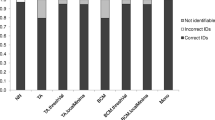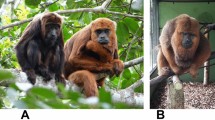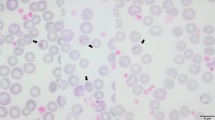Abstract
Epidemics have significant impacts on primate populations. In 2016, yellow fever spread rapidly to the most densely populated states of Brazil, resulting in the death of hundreds of humans and thousands of nonhuman primates. The Yellow Fever Surveillance Program (Programa de Vigilância da Febre Amarela) implemented by the Brazilian government was designed to prevent and control yellow fever outbreaks. In 2020, the regional reference laboratory at the Oswaldo Cruz Institute in Rio de Janeiro state in Brazil, responsible for yellow fever diagnosis, gave us access to 24 DNA samples from capuchin monkeys, which had tested negative for yellow fever virus. The samples were all from sites in Brazil where Sapajus nigritus is the only species of capuchin monkey present. We attempted to sequence two mitochondrial molecular markers commonly used for Cebidae, but five samples did not amplify. In this study, we performed additional DNA amplification and the Basic Local Alignment Search Tool (BLAST) to confirm the species identity of the 19 samples, which amplified and identify the taxon of the five samples that had failed to amplify. Among the 19 samples correctly identified as Sapajus, one was not Sapajus nigritus but another Sapajus species. Of the five samples that previously failed to amplify, three were similar to Callicebus nigrifrons, one was similar to Alouatta guariba clamitans, and one failed to amplify successfully for any marker. These findings show an error rate of 5/24 (21%) in the original taxonomic identification. Misidentification occurred at the genus level as well as the species level. Our findings highlight the importance of precise taxonomic classification in obtaining reliable data on the consequences of the yellow fever epidemic for primates.


Similar content being viewed by others
References
Almeida, M. A., Dos Santos, E., da Cruz Cardoso, J., da Fonseca, D. F., Noll, C. A., Silveira, V. R., Maeda, A. Y., Souza, R. P., Kanamura, C., & Brasil, R. A. (2012). Yellow fever outbreak affecting Alouatta populations in southern Brazil (Rio Grande do Sul State), 2008–2009. American Journal of Primatology, 74(1), 68–76. https://doi.org/10.1002/ajp.21010
Andrade, M. S., Campos, F. S., Campos, A. A. S., Abreu, F. V. S., Melo, F. L., Sevá, A. P., Cardoso, J. C., Santos, E., Born, L. C., Silva, C. M. D., Muller, N. F. D., Oliveira, C. H., Silva, A. J. J., Simonini-Teixeira, D., Bernal-Valle, S., Mares-Guia, M. A. M. M., Albuquerque, G. R., Romano, A. P. M., Franco, A. C., Ribeiro, B. M., Roehe, P. M., & Almeida, M. A. B. (2021). Real-Time Genomic Surveillance during the 2021 Re-Emergence of the Yellow Fever Virus in Rio Grande do Sul State, Brazil. Viruses, 13(10), Article 1976. https://doi.org/10.3390/v13101976
Andújar, C., Arribas, P., Yu, D. W., Vogler, A. P., & Emerson, B. C. (2018). Why the COI barcode should be the community DNA metabarcode for the metazoa. Molecular Ecology, 27(20), 3968–3975. https://doi.org/10.1111/mec.14844
Berthet, M., Mesbahi, G., Duvot, G., Zuberbühler, K., Cäsar, C., & Bicca-Marques, J. C. (2021). Dramatic decline in a titi monkey population after the 2016–2018 sylvatic yellow fever outbreak in Brazil. American Journal of Primatology, 83(12), Article e23335. https://doi.org/10.1002/ajp.23335
Bicca-Marques, J. C., Calegaro-Marques, C., Rylands, A. B., Strier, K. B., Mittermeier, R. A., Almeida, M. A. B., Castro, P. H. G., Chaves, O. M., Ferraz, L. P., Fortes, V., Hirano, Z. M. B., Jerusalinsky, L., Kowalewski, M. M., Martins, W. P., Melo, F. R., Mendes, S. L., Neves, L. G., Passos, F., Port-Carvalho, M., Ribeiro, S., Romano, A. P. M., Ruiz-Miranda, C. R., Santos, E. O., Souza Junior, J. C., & Teixeira, D. S. (2017). Yellow fever threatens Atlantic Forest primates. Science Advances, 3(1), e1600946 tab-e-letters.
Boubli, J. P., Rylands, A. B., Farias, I. P., Alfaro, M. E., & Alfaro, J. L. (2012). Cebus phylogenetic relationships: a preliminary reassessment of the diversity of the untufted capuchin monkeys. American Journal of Primatology, 74(4), 381–393. https://doi.org/10.1002/ajp.21998
Byrne, H., Rylands, A. B., Carneiro, J. C., Alfaro, J. W., Bertuol, F., Silva, M. N. F., Messias, M., Groves, C. P., Mittermeier, R. A., Farias, I., Hrbek, T., Schneider, H., Sampaio, I., & Boubli, J. P. (2016). Phylogenetic relationships of the New World titi monkeys (Callicebus): first appraisal of taxonomy based on molecular evidence. Frontiers in Zoology, 13(10), 1–25. https://doi.org/10.1186/s12983-016-0142-4
Callender, D. M. (2019). Management and control of yellow fever virus: Brazilian outbreak January-April, 2018. Global Public Health, 14(3), 445–455. https://doi.org/10.1080/17441692.2018.1512144
Chame, M., Abdalla, L., Pinter, A., Romano, A. P. M., Krempser, E., Ramos, D. G., Passos, P. H. O., Silva, P. C. L., Silva, G. M. P., Gatti, R. R., & Augusto, D. A. (2020). Primates in SISS-Geo: potential contributions of mobile technology, health surveillance and citizen science to support species conservation in Brazil. Neotropical Primates, 26(2), 80–89. https://doi.org/10.62015/np.2020.v26.42
Chen, L. H., & Wilson, M. E. (2020). Yellow fever control: current epidemiology and vaccination strategies. Tropical Diseases, Travel Medicine and Vaccines, 6, Article 1. https://doi.org/10.1186/s40794-020-0101-0
Fernandes, N. C. C. A., Cunha, M. S., Guerra, J. M., Diaz-Delgado, J., Ressio, R. A., Cirqueira, C. S., Kanamura, C. T., Fuentes-Castillo, D., & Catão-Dias, J. L. (2021). Yellow Fever as Cause of Death of Titi Monkeys (Callicebus spp.). Veterinary Pathology, 58(4), 730–735. https://doi.org/10.1177/03009858211009781
Fernández, D., Kerhoas, D., Dempsey, A., Billany, J., McCabe, G., & Argirova, E. (2022). The current status of the world’s primates: Mapping threats to understand priorities for primate conservation. International Journal of Primatology, 43(1), 15–39. https://doi.org/10.1007/s10764-021-00242-2
Ferrari, S. F., Veiga, L. M., Pinto, L. P., Marsh, L. K., Mittermeier, R. A., & Rylands, A. B. (2013). Family Pitheciidae (Titis, Sakis and Uacaris). In Mittermeier, R.A., Rylands, A.B. & Wilson, D.E (Eds.), Handbook of the Mammals of the World – Volume 3 (pp. 470). Lynx Edicions.
Folmer, O., Black, M., Hoeh, W., Lutz, R., & Vrijenhoek, R. (1994). DNA primers for amplification of mitochondrial cytochrome c oxidase subunit I from diverse metazoan invertebrates. Molecular Marine Biology and Biotechnology, 3(5), 294–299.
Giovanetti, M., Pinotti, F., Zanluca, C., Fonseca, V., Nakase, T., Koishi, A. C., Tscha, M., Soares, G., Dorl, G. G., Marques, A. E. M. L., Souza, R., Adelino, T. E. R., Xavier, J., Oliveira, C., Silva, S. P., Guimarães, N. R., Fritsch, H., Mares-Guia, M. A. M. M., Levy, F., Passos, P. H., Silva, V. L., Pereira, L. A., Mendonça, A. F., Macêdo, I. L., Sousa, D. E. R., Costa, G. R. T., Castro, M. B., Iani, F. C. M., Pereira, M. A., Cavalcante, K. R. L. J., Freitas, A. R. R., Albuquerque, C. F. C., Macário, E. M., Anjos, M. P. D., Ramos, R. C., Campos, A. A. S., Pinter, A., Chame, M., Abdalla, L., Riediger, I. N., Ribeiro, S. P., Bento, A. I., Oliveira, T., Freitas, C., Moura, N. F. O., Fabri, A., Rodrigues, C. D. S., Santos, C. C., Almeida, M. A. B., Santos, E., Cardoso, J., Augusto, D. A., Krempser, E., Mucci, L. F., Gatti, R. R., Cardoso, S. F., Fuck, J. A. B., Lopes, M. G. D., Belmonte, I. L., Silva, G. M. P., Soares, M. R. F., Castilhos, M. M. S., Silva, J. C. S., Bisetto Junior, A., Pouzato, G., Tanabe, L. S., Arita, D. A., Matsuo, R., Raymundo, J. S., Silva, P. C. L., Silva, A. S. A. F., Samila, S., Carvalho, G., Stabeli, R., Navegantes, W., Moreira, L. A., Ferreira, A. G. A., Pinheiro, G. G., Nunes, B. T. D., Medeiros, D. B. A., Cruz, A, C. R., Cunha, R. V., Voorhis, W. V., Fillipis, A. M. B., Almiron, M., Holmes, E. C., Ramos, D. G., Romano, A., Lourenço, J., Alcantara, L. C. J., & Santos, C. N. D. (2023). Genomic epidemiology sheds light on the recent spatio-temporal dynamics of Yellow Fever virus and the spatial corridor that fueled its ongoing emergence in southern Brazil. MedRxiv 23284525. https://doi.org/10.1101/2023.01.13.23284525
Hebert, P. D., Cywinska, A., Ball, S. L., & de Waard, J. R. (2003). Biological identifications through DNA barcodes. Proceedings Biological Sciences, 270(1512), 313–321. https://doi.org/10.1098/rspb.2002.2218
Ishii, K., & Fukui, M. (2001). Optimization of annealing temperature to reduce bias caused by a primer mismatch in multitemplate PCR. Applied and Environmental Microbiology, 67(8), 3753–3755. https://doi.org/10.1128/AEM.67.8.3753-3755.2001
Jerusalinsky, L., Bicca-Marques, J. C., Neves, L.G., Alves, S. L., Ingberman, B., Buss, G., Fries, B. G., Alonso, A. C., da Cunha, R. G. T., Miranda, J. M. D., Talebi, M., Melo, F. R., Mittermeier, R. A., & Cortes-Ortíz, L. (2021). Alouatta guariba. The IUCN Red List of Threatened Species https://doi.org/10.2305/IUCN.UK.2021-1.RLTS.T39916A190417874.en. Accessed 10 May 2023.
Klippel, A. H., Oliveira, P. V., Britto, K. B., Freire, B. F., Moreno, M. R., Santos, A. R., Banhos, A., & Paneto, G. G. (2015). Using DNA barcodes to identify road-killed animals in two Atlantic forest nature reserves, Brazil. PloS One, 10(8), Article e0134877. https://doi.org/10.1371/journal.pone.0134877
Lima, M. G. M., Silva-Júnior, J. S. E., Černý, D., Buckner, J. C., Aleixo, A., Chang, J., Zheng, J., Alfaro, M. E., Martins, A., Di Fiore, A., Boubli, J. P., & Lynch-Alfaro, J. W. (2018). A phylogenomic perspective on the robust capuchin monkey (Sapajus) radiation: First evidence for extensive population admixture across South America. Molecular Phylogenetics and Evolution, 124, 137–150. https://doi.org/10.1016/j.ympev.2018.02.023
Lynch Alfaro, J. W., Silva, J. D. S. E., Jr., & Rylands, A. B. (2012). How different are robust and gracile capuchin monkeys? An argument for the use of Sapajus and Cebus. American Journal of Primatology, 74(4), 273–286. https://doi.org/10.1002/ajp.22007
Lynch-Alfaro, J. W., Izar, P., & Ferreira, R. G. (2014). Capuchin monkey research priorities and urgent issues. American Journal of Primatology, 76(8), 705–720. https://doi.org/10.1002/ajp.22269
Mares-Guia, M. A. M. M., Horta, M. A., Romano, A., Rodrigues, C. D. S., Mendonça, M. C. L., Santos, C. C., Torres, M. C., Araujo, E. S. M., Fabri, A., Souza, E. R., Ribeiro, R. O. R., Lucena, F. P., Junior, L. C. A., Cunha, R. V., Nogueira, R. M. R., Sequeira, P. C., & Filippis, A. M. B. (2020). Yellow fever epizootics in non-human primates, Southeast and Northeast Brazil (2017 and 2018). Parasites & Vectors, 13(1), Article 90. https://doi.org/10.1186/s13071-020-3966-x
Martins, A. B., Valença-Montenegro, M. M., Lima, M. G. M., Lynch, J. W., Svoboda, W. K., Silva-Junior, J. S., Rohe, F., Boubli, J. P., & Di Fiore, A. (2023). A new assessment of robust Capuchin monkey (Sapajus) evolutionary history using genome-wide SNP marker data and a Bayesian approach to species delimitation. Genes, 14(5), 970. https://doi.org/10.3390/genes14050970
Ministério da Saúde (2014). Guide to epizootics surveillance in non-human primates and entomology applied to the Yellow Fever Surveillance (2nd edn). Ministério da Saúde, Secretaria de Vigilância em Saúde, Departamento de Vigilância das Doenças Transmissíveis. https://www.gov.br/saude/pt-br/assuntos/saude-de-a-a-z/f/febre-amarela/publicacoes/guia_vigilancia_epizootias_primatas_entomologia.pdf/view
Oklander, L. I., Buss, G., Bicca-Marques, J. C., Hirano, Z. B., Chaves, O. M., Jardim, M. M. A., Valença-Montenegro, M., Mendes, S. L., Neves, L. G., Kowalewski, M., Melo, F. R., Rylands, A. B., & Jerusalinsky, L. (2022). Brown Howler Monkey Alouatta guariba (Humboldt, 1812). In: R. A. Mittermeier, K. E. Reuter, A. B. Rylands, L. Jerusalinsky, C. Schwitzer, K. B. et al (Eds.), Primates in Peril: The World’s 25 Most Endangered Primates 2022–2023 (pp. 121–125). IUCN SSC Primate Specialist Group, International Primatological Society, Re:wild, Washington, DC.
Organização Pan-Americana da Saúde. (2023, May). Tópicos: Febre Amarela. OPAS/OMS: Washington, DC, USA. https://www.paho.org/pt/topicos/febre-amarela
Possamai, C. B., Rodrigues de Melo, F., Mendes, S. L., & Strier, K. B. (2022). Demographic changes in an Atlantic Forest primate community following a yellow fever outbreak. American Journal of Primatology, 84(9), Article e23425. https://doi.org/10.1002/ajp.23425
Possas, C., Lourenço-de-Oliveira, R., Tauil, P. L., Pinheiro, F. P., Pissinatti, A., Cunha, R. V., Freire, M., Martins, R. M., & Homma, A. (2018). Yellow fever outbreak in Brazil: the puzzle of rapid viral spread and challenges for immunisation. Memorias do Instituto Oswaldo Cruz, 113(10), Article e180278. https://doi.org/10.1590/0074-02760180278
Ruvolo, M., Zehr, S., von Dornum, M., Pan, D., Chang, B., & Lin, J. (1993). Mitochondrial COII sequences and modern human origins. Molecular Biology and Evolution, 10(6), 1115–1135. https://doi.org/10.1093/oxfordjournals.molbev.a040068
Rylands, A. B., Mittermeier, R. A., Bezerra, B. M., Paim, F. P., & Queiroz, H. L. (2013a). Family Cebidae (Squirrel Monkeys and Capuchins). In R. A., Mittermeier, A. B., Rylands, & D. E. Wilson (Eds.) Handbook of the Mammals of the World – Volume 3 (pp. 348–389). Lynx Edicions.
Rylands, A. B., Mittermeier, R. A., Cornejo, F. N., Defler, T. R., Glander, K. E., Konstant, W. R., Pinto, L. P., & Talebi, M. (2013b). Family Atelidae (howlers, spider and woolly monkeys and muriquis). In R. A., Mittermeier, A. B., Rylands, & D. E., Wilson (eds.) Handbook of the mammals of the world – Volume 3 (pp. 501). Lynx Edicions.
Sacchetto, L., Silva, N. I. O., Rezende, I. M., Arruda, M. S., Costa, T. A., Mello, E. M., Oliveira, G. F. G., Alves, P. A., Mendonça, V. E., Stumpp, R. G. A. V., Prado, A. I. A., Paglia, A. P., Perini, F. A., Nogueira, M. L., Kroon, E. G., Thoisy, B., Trindade, G. S., & Drumond, B. P. (2020). Neighbor danger: Yellow fever virus epizootics in urban and urban-rural transition areas of Minas Gerais state, during 2017-2018 yellow fever outbreaks in Brazil. PLoS Neglected Tropical Diseases, 14(10), Article e0008658. https://doi.org/10.1371/journal.pntd.0008658
Silva, N. I. O., Sacchetto, L., de Rezende, I. M., Trindade, G. S., LaBeaud, A. D., Thoisy, B., & Drumond, B. P. (2020). Recent sylvatic yellow fever virus transmission in Brazil: the news from an old disease. Virology Journal, 17(1), Article 9. https://doi.org/10.1186/s12985-019-1277-7
Strier, K. B., Tabacow, F. P., de Possamai, C. B., Ferreira, A. I. G., Nery, M. S., Melo, F. R., & Mendes, S. L. (2019). Status of the northern muriqui (Brachyteles hypoxanthus) in the time of yellow fever. Primates, 60(1), 21–28. https://doi.org/10.1007/s10329-018-0701-8
Szynwelski, B. E., Mares‐Guia, M. A. M. M., Filippis, A. M. B., Gonçalves, G. L., Tokuda, M., Wagner, P. G. C., Wu, S., Oliveira, V. P., Lima, M. G. M., Lynch, J. W., & Freitas, T. R. O. F. (2023). Phylogeography, genetic diversity, and intraspecific genetic structure of the black‐horned capuchin (Sapajus nigritus). American Journal of Primatology, 85(11), Article e23566. https://doi.org/10.1002/ajp.23566
Acknowledgments
We are grateful to the two anonymous peer reviewers and to the Associate and Editor-in-Chief editors for their constructive comments. This study was supported by the National Council for Scientific and Technological Development (CNPq) (Process No. 141708/2019-0 [BES]) and the Rio Grande do Sul Research Foundation (FAPERGS) (Process No. 16/0485-4 [TROF]). The Arbovirus Laboratory is grateful for the support provided by the Rio de Janeiro Research Foundation (FAPERJ) (Grant No. E-26/202.930/2016) and the Coordenação de Vigilância em Saúde e Laboratórios de Referência (Oswaldo Cruz Foundation, Ministry of Health, Brazil).
Author information
Authors and Affiliations
Corresponding author
Ethics declarations
Inclusion and Diversity Statement
The author list includes contributors from the location where the research was conducted, who participated in study conception, study design, data collection, analysis, and interpretation of the findings.
Additional information
Handling Editor: Julio Cesar Bicca-Marques
Supplementary Information
Below is the link to the electronic supplementary material.
Rights and permissions
Springer Nature or its licensor (e.g. a society or other partner) holds exclusive rights to this article under a publishing agreement with the author(s) or other rightsholder(s); author self-archiving of the accepted manuscript version of this article is solely governed by the terms of such publishing agreement and applicable law.
About this article
Cite this article
Szynwelski, B.E., Cruz, M.M., de Mello Mares-Guia, M.A.M. et al. Mitochondrial DNA Sequencing and BLAST Analysis Reveal Visual Misidentification of Nonhuman Primates Suspected to have Died of Yellow Fever in Brazil in 2017–2020. Int J Primatol (2024). https://doi.org/10.1007/s10764-024-00426-6
Received:
Accepted:
Published:
DOI: https://doi.org/10.1007/s10764-024-00426-6




